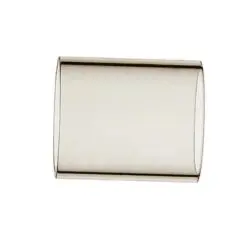Description
Torch Fixed 1.5mm Injector 1 Pin 450-90
P/N: 450-90
Cross Reference(s)
Thermo: 3601203
Instrument Compatibility:
Thermo X-Series
Detail:
Fixed 1.5mm injector, additional inlet, single locator pin, for Thermo X-Series
What is the Role of the ICP Torch?
A plasma is an ionized gas, consisting of positively charged ions and free (unbound) electrons. The role of the plasma (ICP) in ICP-MS is to ionize the sample. In contrast to so-called ‘soft’ ionization sources in other forms of mass spectrometry, the ICP is a ‘hard’ ionization technique because it completely atomizes most molecules in the sample.
ICP-MS instruments use an argon plasma, although helium plasma is also an option. Although there are several advantages to using helium, argon is the gas of choice since the cost of helium is prohibitive.
What Makes the Torch Work?
Plasma forms at the end of three concentric quartz tubes, collectively known as the torch. Argon gas flows through all three tubes.
- The inner tube is the injector and contains the sample aerosol in a stream of argon that delivers the sample to the plasma.
- Concentric to this tube is another tube of argon. This is the auxiliary gas that forms the plasma.
- The outer argon tube is a cooling layer to prevent the torch from melting.
- The far end of the torch has a copper induction coil (or ‘load coil’) surrounding it that connects to a radio frequency (RF) generator.
How the ICP Torch Ionizes a Sample
The RF generator supplies power to the load coil, creating a high-frequency alternating current. This, in turn, induces a time-varying electromagnetic field in the torch. As a result, with argon gas flowing through the torch, the application of a high-voltage discharge (called a Tesla spark) ionizes a fraction of the argon atoms generating ions and electrons.
The electromagnetic field in the torch then acts on the ions and electrons. As a result, they accelerate and collide with other argon atoms. If these collisions impart enough energy, additional atoms ionize creating electrons and ions that propagate the cascade.
As a result, the movement of electrons and ions in the torch generates tremendous heat. The result is an ICP, which reaches a temperature of up to 10,000 Kelvin (hotter than the surface of the sun).
What Is PFA Inert?
PFA is frequently employed as an inert substance in sample equipment on geochemical or environmental analytical chemistry field sites to assist in avoiding trace amounts of metallic ion contamination.
Features of Torch Fixed 1.5mm Injector 1 Pin 450-90
Single Piece Torch
Single-piece inductively coupled plasma (ICP) torches have narrow bore injectors (1.0 mm or 1.5 mm) designed to improve plasma stability and reduce plasma loading when used with organic solvents. They are the least expensive type of torch to buy initially, but they are also the least versatile and must be replaced entirely if any component is damaged. Single-piece torches can also be expensive consumables that require regular maintenance and replacement, especially when used with aggressive sample matrices like hydrofluoric acid, organic solvents, and high total dissolved solids.
Do you have questions about Torch Fixed 1.5mm Injector 1 Pin 450-90? Call Precision Glassblowing to Learn More.
Do you have questions? Visit our FAQs or Technical Information. And, there are several ways to contact Precision Glassblowing. Click here to pick one that works for you.




